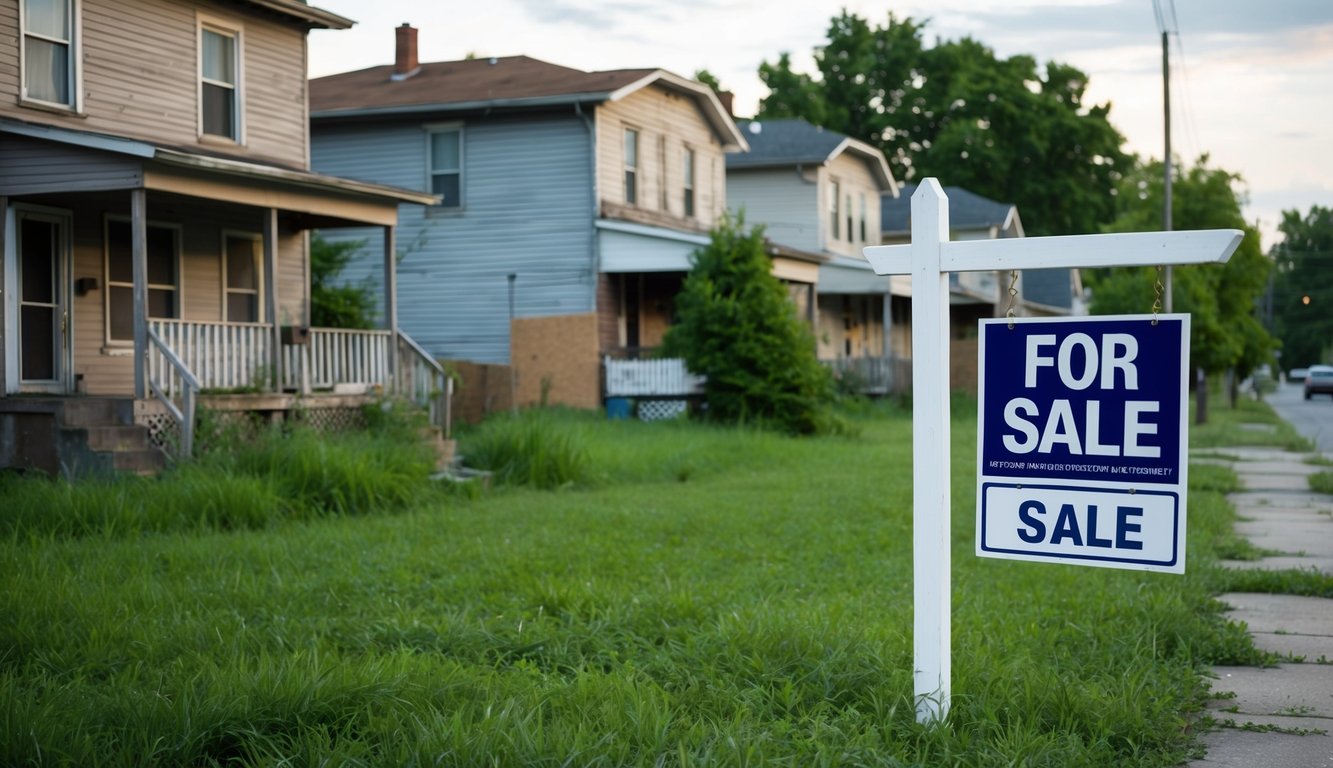When economic conditions combine stagnant growth with rising inflation, real estate investors face unique challenges and opportunities. The 1970s demonstrated how real estate investments can protect purchasing power during periods of stagflation, offering valuable lessons for today’s market environment.
Real estate investments tend to outperform stocks and bonds during stagflation, particularly when leveraged with fixed-rate financing that gets devalued by inflation while the underlying asset value typically rises with inflationary pressures. Investment properties maintain their relative value as rental income adjusts upward with inflation, providing a natural hedge against economic uncertainty.
Key Takeaways
- Real estate historically outperforms traditional investments during stagflation periods
- Fixed-rate leverage amplifies returns as inflation erodes debt value
- Income properties provide natural inflation protection through rent adjustments
Stagflation: The Economic Perfect Storm That Keeps Coming Back

Stagflation combines stagnation and inflation, creating a challenging economic environment where prices rise while growth slows down. The most recent GDP data shows this pattern emerging, with growth dropping to 1.6% in Q1 2024 while inflation remains elevated.
You might recognize this pattern from the 1970s when the OPEC oil crisis triggered the first major stagflation period. The key ingredients remain similar today: supply chain disruptions, rising energy costs, and monetary policy challenges.
The Federal Reserve faces a difficult balancing act during stagflation. Traditional tools that fight inflation can worsen economic stagnation, while measures to boost growth might fuel further price increases.
Key indicators of stagflation include:
- Rising consumer price index
- Slowing economic growth
- Persistent unemployment
- Increasing commodity prices
- Supply chain bottlenecks
Raw material costs and energy prices play crucial roles in triggering stagflation. When these increase significantly, they create a ripple effect throughout the economy, pushing prices up while constraining production and growth.
Your purchasing power diminishes during stagflation as wages typically don’t keep pace with inflation. This creates a challenging environment for both consumers and businesses, as demand weakens while costs continue to rise.
What The 1970s Taught Us About Real Estate’s Resilience
Real estate proved remarkably adaptable during the challenging economic conditions of the 1970s. The decade demonstrated how property can act as a powerful hedge against inflation, protecting your purchasing power when other assets struggle.
Agricultural properties and commercial real estate generated strong returns even after accounting for inflation. This performance highlighted real estate’s ability to maintain value during periods of economic uncertainty.
Your location choice mattered significantly. While some regions saw residential real estate values merely keep pace with inflation, others experienced substantial appreciation beyond the inflation rate.
The rental market demonstrated particular strength during this period. Rising rents helped property owners offset increased costs while providing steady income streams.
Strategic thinking became essential for success. Properties with shorter lease terms allowed owners to adjust rates more frequently, helping maintain profitability as costs rose.
The period revealed that real estate investing requires active management. Your ability to adapt to changing market conditions – through rent adjustments, property improvements, or strategic acquisitions – often determined success.
Cash flow management emerged as a critical skill. Properties generating strong cash flows provided better protection against economic uncertainty than those focused purely on appreciation potential.
Smart Moves For Real Estate Investors When Growth Stalls And Prices Soar

Hard assets serve as a crucial defense during stagflation. Real estate investments offer protection against both stagnant economic growth and rising taxes and prices.
You can target income-producing properties in stable markets. Multi-family units and commercial properties with long-term leases provide steady rental income streams despite economic uncertainty.
REITs offer diversification benefits while maintaining liquidity. These investment vehicles let you participate in real estate markets without direct property management responsibilities.
Consider value-add properties that need improvements. Renovating and upgrading properties can increase rental income potential even when broader market growth slows.
Fixed-rate mortgages become valuable tools during inflationary periods. Locking in rates before they climb higher helps maintain predictable expenses while property values and rents rise with inflation.
Focus on properties with strong cash flow fundamentals. Look for locations with steady employment, growing populations, and limited new construction to maintain occupancy rates.
Tax benefits remain important during stagflation. Investment properties offer deductions for mortgage interest, property taxes, depreciation, and operating expenses.
Avoid highly leveraged investments during uncertain times. Having sufficient cash reserves helps weather periods of market volatility or unexpected expenses.
Professional property management becomes crucial. Skilled managers can adjust rents appropriately, control costs, and maintain occupancy levels when market conditions tighten.
Frequently Asked Questions
Rising prices, falling economic growth, and declining asset values create unique challenges and opportunities in real estate markets during stagflation. Smart investors can still generate returns through strategic property investments and careful mortgage planning.
How do housing prices typically react in a stagflation environment?
Property prices tend to decline in real terms during stagflation after adjusting for inflation. The combination of high interest rates and reduced economic activity puts downward pressure on home values.
You’ll see reduced buyer demand as mortgage costs increase and household incomes stagnate. This creates opportunities for cash buyers but challenges for financing-dependent purchasers.
What are the historical effects of stagflation on the real estate market?
The 1970s stagflation period saw real estate serve as a wealth preservation tool alongside gold and energy investments. Property values maintained purchasing power better than stocks and bonds.
Fixed-rate mortgages taken before interest rate hikes became valuable assets as inflation eroded the real cost of debt repayment.
Which types of real estate investments perform best during periods of stagflation?
Income-generating rental properties tend to outperform during stagflation. You can adjust rents to keep pace with inflation while maintaining steady cash flow.
Multi-family units and commercial properties with strong tenants provide reliable income streams even as broader economic growth slows.
How does stagflation influence mortgage rates and home affordability?
Central banks typically raise interest rates to combat the inflationary component of stagflation. This drives up mortgage rates and reduces affordability for buyers relying on financing.
Your existing fixed-rate mortgage becomes more advantageous as inflation erodes the real value of your debt payments over time.
What strategies should real estate investors consider during stagflation?
Focus on properties with strong cash flow potential rather than speculating on appreciation. You’ll want to lock in fixed-rate financing before rates rise further.
Consider consumer staples-oriented commercial properties like grocery-anchored retail centers that maintain steady tenant demand regardless of economic conditions.
Can real estate investment serve as a hedge against stagflation?
Real estate can provide inflation protection through rising rents and property values that track inflation over time. Your fixed-rate mortgage debt also becomes less burdensome in real terms.
Physical property offers similar inflation-hedging benefits to precious metals while generating income – unlike gold or silver holdings.
Here’s where the savviest investors find their best deals…
Access the largest database of foreclosure properties nationwide and discover below-market deals before other investors. Start your search today!

Are you a contrarian investor with the foresight to spot opportunities where others see only chaos?
Rental Property Management in a Market Crash is your essential guide to navigating turbulent economic waters. Learn how to capitalize on market downturns that inevitably occur, drawing parallels between the Global Financial Crisis of 2007-09 and current market conditions.
This book offers invaluable insights into the dynamics of the housing market during a downturn, equipping you with the knowledge to make informed decisions and build a resilient investment portfolio.
Don’t just weather the storm – learn to thrive in it. Get your copy now from your favorite bookseller:
- Amazon as an ebook
- Books2Read for Apple, Barnes & Noble, Kobo, Scribed, and 8 more sellers with both eBook and paperback options available
- Payhip as a downloadable PDF
Ready to move to the next level?
- Visit our learning center
- Learn more about our consulting services
This blog post was written by J. Scott Digital content creation services.



